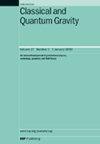Fighting Newtonian noise with gradient-based optimization at the Einstein Telescope
IF 3.6
3区 物理与天体物理
Q2 ASTRONOMY & ASTROPHYSICS
引用次数: 0
Abstract
Newtonian noise in gravitational wave detectors originates from density fluctuations in the vicinity of the interferometer mirrors. At the Einstein Telescope, this noise source is expected to be dominant for low frequencies. Its impact is proposed to be reduced with the help of an array of seismometers that will be placed around the interferometer endpoints. We reformulate and implement the problem of finding the optimal seismometer positions in a differentiable way. We then explore the use of first-order gradient-based optimization for the design of the seismometer array for 1 Hz and 10 Hz and compare its performance and computational cost to two metaheuristic algorithms. For 1 Hz, we introduce a constraint term to prevent unphysical optimization results in the gradient-based method. In general, we find that it is an efficient strategy to initialize the gradient-based optimizer with a fast metaheuristic algorithm. For a small number of seismometers, this strategy results in approximately the same noise reduction as with the metaheuristics. For larger numbers of seismometers, gradient-based optimization outperforms the two metaheuristics by a factor of 2.25 for the faster of the two and a factor of 1.4 for the other one, which is significantly outperformed by gradient-based optimization in terms of computational efficiency.在爱因斯坦望远镜上用梯度优化对抗牛顿噪声
引力波探测器中的牛顿噪声来源于干涉仪反射镜附近的密度波动。在爱因斯坦望远镜中,这种噪声源预计在低频中占主导地位。建议在干涉仪端点周围放置一组地震仪,以减少其影响。我们以一种可微分的方式重新制定并实现了寻找地震仪最佳位置的问题。然后,我们探索了使用一阶梯度优化设计1 Hz和10 Hz地震仪阵列,并将其性能和计算成本与两种元启发式算法进行了比较。对于1 Hz,我们引入了一个约束项,以防止基于梯度的方法中的非物理优化结果。通常,我们发现用快速的元启发式算法初始化基于梯度的优化器是一种有效的策略。对于少量地震仪,该策略的降噪效果与元启发式方法大致相同。对于数量较多的地震仪,基于梯度的优化比两种元启发式方法的计算效率高2.25倍,比另一种方法的计算效率高1.4倍,在计算效率方面明显优于基于梯度的优化。
本文章由计算机程序翻译,如有差异,请以英文原文为准。
求助全文
约1分钟内获得全文
求助全文
来源期刊

Classical and Quantum Gravity
物理-天文与天体物理
CiteScore
7.00
自引率
8.60%
发文量
301
审稿时长
2-4 weeks
期刊介绍:
Classical and Quantum Gravity is an established journal for physicists, mathematicians and cosmologists in the fields of gravitation and the theory of spacetime. The journal is now the acknowledged world leader in classical relativity and all areas of quantum gravity.
 求助内容:
求助内容: 应助结果提醒方式:
应助结果提醒方式:


